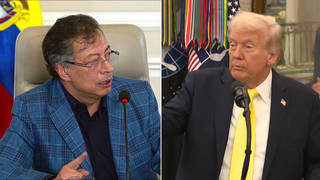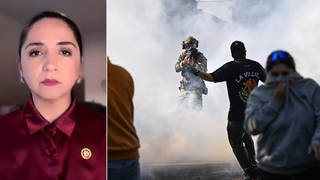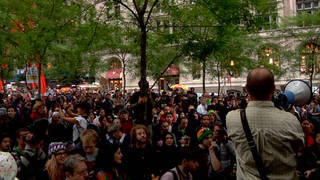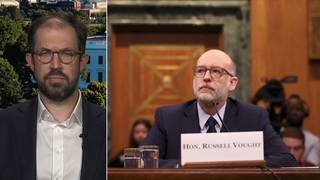
Guests
- Nomi Prinsformer investment banker turned journalist. She worked at Goldman Sachs and Bear Stearns. She is the author of several books, including It Takes a Pillage: Behind the Bonuses, Bailouts, and Backroom Deals from Washington to Wall Street.
Democrats may still be one vote short of approving an overhaul of financial regulation with Senator Russ Feingold vowing to vote against the measure again. The House approved the measure this week following over three weeks of conference committee negotiations. We speak to former investment banker turned journalist Nomi Prins, author of several books, including It Takes a Pillage: Behind the Bonuses, Bailouts, and Backroom Deals from Washington to Wall Street. [includes rush transcript]
Transcript
AMY GOODMAN: We begin today’s show looking at the massive financial reform bill being considered by Congress. The Senate moved closer to approving legislation Thursday, when Democratic Senator Maria Cantwell of [Washington] said she would now back the bill. Cantwell and Russ Feingold of Wisconsin were the only two Democrats to oppose the legislation when an earlier version of the bill was passed by the Senate in May. Due to the death of Democratic Senator Robert Byrd of West Virginia, Democrats may still be one vote short of the sixty needed to overcome a Republican filibuster.
Earlier this week, large Wall Street firms scored a key victory on Capitol Hill when the Democrats stripped a $17.9 billion fee on large financial institutions as part of efforts to win the support of Republican Senator Scott Brown of Massachusetts. While Brown is now expected to support the overall bill, Democratic Senator Russ Feingold of Wisconsin has vowed to vote against the bill again. He explained why in a recent video message.
SEN. RUSS FEINGOLD: Unfortunately, this bill doesn’t do the job. The job was to make sure that we don’t have a financial collapse on Wall Street again. And this bill does not get at the core problems that led to the collapse. And this collapse was devastating for our economy, for the world economy, and very hard on many, many Wisconsin families.
Two major things that weren’t addressed, the most important things. First of all, it does nothing to put that firewall back up between regular banking commercial activity and those investment firms on Wall Street. That distinction was critical to protect all of us from this kind of collapse. I voted against taking that firewall away. This bill doesn’t fix it. The second thing is it doesn’t do anything serious about these institutions, these investment companies and others that are too big to fail — and too big to be safe for America. It does not handle that. So the two biggest issues aren’t resolved. To pretend that this is somehow the kind of reform we needed to avoid the financial collapse of the past is really not being honest with the American people.
I’m not going to be able to support it, because my commitment, after having tried to prevent this all from happening in the first place, being one of only eight senators to vote against repealing the Glass-Steagall bill that was the one that kept these distinctions in place, having voted against the Wall Street bailout, there’s no way I’m going to vote for something that doesn’t do the job and try to tell people in Wisconsin that it does do the job.
AMY GOODMAN: Democratic Senator Russ Feingold of Wisconsin. Meanwhile, House Speaker Nancy Pelosi has described the bill as “the toughest set of Wall Street [reform] in generations.”
REP. NANCY PELOSI: Today we will follow the lead of those on the committee enacting historic legislation to bring transparency to our financial markets, lowering the leverage that got us into this trouble in the first place, brings tough oversight to Wall Street, and brings consumer protections to Main Street and to the American people. By voting yes, we will pass the toughest set of Wall Street reform in generations. This comprehensive and far-reaching legislation injects transparency and accountability, as it lowers leverage into the financial system run amok under the Republicans’ reckless economic policies.
AMY GOODMAN: To talk more about the financial reform legislation, we’re joined by Nomi Prins. She’s a former investment banker turned journalist. She worked at Goldman Sachs and Bear Stearns. She’s the author of several books, including It Takes a Pillage: Behind the [Bailouts, Bonuses,] and Backroom Deals from Washington to Wall Street.
Nomi, thanks for coming in. Your assessment of the legislation?
NOMI PRINS: Well, I agree with Russell. I think that the bill itself does not fundamentally transform the landscape of Wall Street — not the mindset, not the way it does business, not the size and complexity of the institutions, and not their power. It makes cosmetic regulatory changes, some of which are administrative, a lot of which are then followed by major exemptions in the same piece of legislation that is supposed to be re-regulating. So, anything that’s even positive in this bill tends to be overshadowed by coming exemptions a few pages later in the same bill. So the net result is things really stay the same. The nature of business stay the same. We don’t not only stop an extra crisis; we don’t really understand, from this bill, it seems, what this crisis was about, to begin with.
AMY GOODMAN: Why is it being billed as the biggest financial reform, what, since FDR?
NOMI PRINS: I think because it’s long. It was fought for for a long time by a lot of haggling on the Hill. I think it’s become a partisan issue, as opposed to a reform issue or a restructuring issue. In the Great Depression in 1933, the act that was passed — the Glass-Steagall Act and the Bank Act, that was a part of the connector to that — transformed the landscape. It disallowed banks to take risks and hold our, slash, customer deposits. And it gave an incentive to banks who held deposits that they would be supported by the government, that the FDIC was created to back our money. But they would then also not be allowed to speculate and trade and create esoteric, complex instruments that are difficult to understand and don’t have a market and can collapse an entire economy. That was a big bill.
1956, there was a Bank Holding Act, that said banks can’t merge across state lines. They can’t buy insurance companies. They can’t buy investment banks. They want to do plain banking, they do plain banking. That was a solidification of the Glass-Steagall Act. That was strengthening the act. This does none of that. This allows all of that complexity. It allows banks to hold insurance companies and investment banks and trade and speculate and have government backing for deposits. It’s kind of a whim.
AMY GOODMAN: Then explain again what it does.
NOMI PRINS: It does create a consumer financial protection agency, which would look at the types of loans that were given to individuals, predatory lending situations, documentation, transparency, credit cards, and be sort of the promoter of the consumer side of the financial equation. And that’s useful.
What’s not useful about it is that it will reside at the Federal Reserve, the same Federal Reserve that not only didn’t see the crisis coming, not because it was a random crisis, but because they refused to look at data they were receiving on housing, on lending, on leverage, every day from the institutions they were supposed to be regulating. So I think there’s going to be fights internally. So it creates the agency, but it puts it in a place where it’s going to be very — it’s going to be a fight every day for whoever’s running that agency. And I hope that’s a fight that, you know, is winnable on a day-to-day basis.
It does have this notion that proprietary trading, where a bank can use its own capital to speculate, is reduced to some extent, and where their investments and hedge funds, private equity funds, sort of more shadow type of funds, is also reduced. But there are several exemptions to that. And the way the bill is written, it could be up to seven years before anything is implemented in terms of banks reducing their hold, their investment in hedge funds, or illiquid types of assets or anything like that. So it does, and then it takes away. And that’s basically the problem with the bill.
AMY GOODMAN: What about the headline that I just read about new details emerging on how the New York Federal Reserve, under Treasury Secretary Timothy Geithner, helped orchestrate the backdoor bailout of major Wall Street firms through the insurance giant AIG? The Fed’s rescue of AIG helped secretly funnel nearly $70 billion to sixteen big US and European banks, according to the Times. New documents show the government forced AIG to forfeit its right to sue several major banks, including Goldman and Merrill Lynch, for irregularities in the mortgage securities that it insured on their behalf.
NOMI PRINS: Yeah, well, basically, Tim Geithner, as head of the New York Fed, the Fed that’s the closest to Wall Street, has the tightest relationships to Wall Street, and happened to have had, as its president at the time, Stephen Friedman, who was also, and is still also, on the board of Goldman Sachs, basically said to AIG, “Look, you have to honor these contracts where you agreed to back certain esoteric, complex instruments that Goldman had you back, and you can’t recourse. You can’t then question them. You can’t sue. You can’t do anything else. We will give you the money. You will give it to those sixteen banks,” the largest recipient of which happened to have been Goldman Sachs at almost $13 billion of that $70 billion.
So this is a guy who did orchestrate that. He was in charge of the institution that provided the funds and agreed to those arrangements, and now, obviously, is the Treasury Secretary. And in the bill, to go full circle, he will be the chairman of a new Financial Services Oversight Council, which is supposed to make decisions on systemic risk on the leverage that Nancy Pelosi was talking about and a slew of other things. So the guy in charge of funneling our money into these banks is the guy who’s going to be more in charge of deciding what to do in the future. I realize he won’t be the Treasury Secretary forever. But the way it is set up, that’s the deal.
AMY GOODMAN: You’re writing a novel about what took place in 1929, so you’re doing a lot of research.
NOMI PRINS: Mm-hmm.
AMY GOODMAN: How does today compare to then?
NOMI PRINS: Well, one of the things that actually got me started on the idea of the novel and looking at what was going on in the banks and what was going on in the working class and the labor class at the time, which were two completely different realities, was just the subterfuge of how things were being reported. For example — and I’ll just give one, there are many — but on Black Thursday, which was one of the first days which became the Crash of 1929, which preceded the Great Depression, five bankers got into a room and said, “We’re going to save the markets.” And, by the way, this wasn’t the government bailing out the markets, of course; this was the bankers themselves saying, “We’re going to put up our own money, and we’re going to save things. We’re egotistical. We’re powerful. We’re scared. We’re going to do this.”
The way it was reported in the New York Times and other places was, by doing this, they averted a crisis — they put their money in, people should be confident, the bankers are doing it, we can do it — and that sucked more people in. The bankers were still scared, though. They knew this wasn’t going to actually save anything. They were in their offices all over the weekend. New York Times reported that as, they’re in their offices working on a positive open for the Monday.
Now, bankers do not hang out on a Sunday because things are going to be positive. We know that from the Sunday during the crisis of 2008, that Goldman Sachs and Morgan Stanley were hanging out at the Fed trying to get themselves converted to bank holding companies so they could get extra government backing for the activities they had screwed up. We know Sundays are generally tense times. They’re not like glowy times. But the same way in which this is all reported, the fact that there were five big bankers then that controlled the markets, the fact that there are six big bankers now, many of which are the same or over time they’ve changed, they’ve merged, they’re dissected, but largely the same players, is very, very parallel.
AMY GOODMAN: Well, I want to thank you very much, Nomi Prins, for joining us. Nomi Prins is not only writing a novel today, but she is a former investment banker. She worked both at Bear Stearns and Goldman Sachs. She also is a journalist, and she wrote It Takes a Pillage: Behind the [Bailouts, Bonuses,] and Backroom Deals from Washington to Wall Street.












Media Options